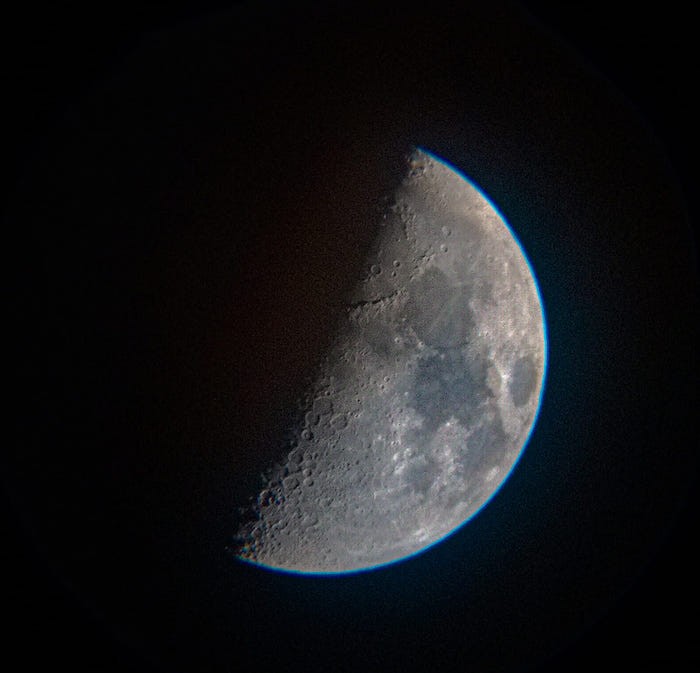Chromatic Aberration

Chromatic aberration is a type of optical distortion where colors don’t come to the same focal point, resulting in a rainbow-like halo around objects, especially bright ones like stars or planets. This aberration is common in cheaper refracting telescopes, which often use only two ordinary crown and flint glass lens elements (achromats); larger and/or stubbier refractors generally have it worse due to the steeper angle at which light enters their lenses. This is why we tend to think of refractors as slender little spyglasses; those were easier to make to acceptable standards of viewing quality in the earlier days of telescopes and optical technology.
Chromatic aberration arises because different colors of light have varying wavelengths, and simple lenses as well as achromatic doublets will bend each color slightly differently. This not only affects the image quality in general but can also severely limit the maximum useful magnification. ED glass and triplet objective lenses are designed to reduce chromatic aberration, but it’s a challenge to navigate this market. Many cheaper ED refractors are designed for astrophotography but still have plenty of chromatic aberration at the eyepiece – as well as other optical defects since these telescopes simply aren’t designed for high magnifications. Additionally, “apochromatic” (ED and/or triplet) refractors are often heavy, expensive, and not really designed for beginners. Our apochromats vs. achromats article goes into more detail on this topic.
Small amounts of chromatic aberration can also be added by your eyepiece or Barlow lens. However, it’s rarely impactful to the view as a whole, rarely prominent, and usually only a single wavelength such as red, orange, yellow, green, or blue. Chromatic aberration of eyepieces, or Barlow, is usually only a problem with low-quality optics or on extremely bright targets where the final image is hardly impacted (namely the Moon and Venus).
Coma

A coma is an optical aberration distinctly recognized by the comet-like or fan-shaped tails that stars take on, especially towards the periphery of the field of view. The name “coma” itself, derived from the Greek word for “hair”, aptly describes the appearance of stars affected by this aberration. They appear stretched out, much like the tail of a comet, with the tails pointing outwards from the center of the field. It’s mostly a problem with lower magnifications and wider fields of view; the further off-axis, the worse the coma, as well as other aberrations.
Coma is most prominent in fast Newtonian reflectors with wide-angle eyepieces or larger camera sensors. Schmidt-Cassegrain telescopes also suffer from coma, but it’s masked by the field curvature of these instruments. The faster the telescope’s focal ratio (a smaller f-number), the more pronounced the coma tends to be. For instance, an f/4 telescope will exhibit a more noticeable coma than an f/6. It’s worth noting that coma only affects the outer field of view as a result of miscollimation. Specialized coma correctors can also be used to eliminate the issue in any case, though they are expensive and no 1.25” units are available.
Astigmatism

Edge-of-field astigmatism occurs with many cheaper wide-angle eyepieces in faster telescopes. Often, it is confused with coma but remains even after the installation of a coma corrector. This is a flaw in some eyepiece designs that is inherent, unfortunately; the only solution is to buy a more well-corrected eyepiece from a reputable manufacturer, and preferably a product that’s advertised as working well in fast f/ratio telescopes too.
Field Curvature
Field curvature occurs when the focal plane is curved rather than flat. This means that while the center of the image might be in sharp focus, the edges appear blurred, or vice versa. At the eyepiece, this can be caused by a bad or incorrectly assembled eyepiece, certain refractors, some Cassegrain designs, or a particularly ill-suited combination of an eyepiece design with certain refractors or Cassegrains.
Most refractors and Schmidt-Cassegrain telescopes have subtle field curvature in astrophotos that is usually corrected with a field flattener or a combination reducer-flattener; if you’re seeing field curvature at the eyepiece, you need to shop for a different ocular. The “reducer-flatteners” sold for Schmidt-Cassegrains are also technically coma correctors, so you need not worry about shopping for more than one accessory to fix the inherent optical issues of these telescopes.
Vignetting
Vignetting is another aspect to consider. Manufacturers usually leave this in to hide some sort of optical imperfection, or the telescope simply has a physical design limitation (for instance, using a 56mm Plossl on a scope that can’t illuminate a 2” eyepiece). While it doesn’t necessarily blur the image, the dimming effect vignetting produces at the edges can detract from the overall viewing experience or wreck your astrophotography plans.
